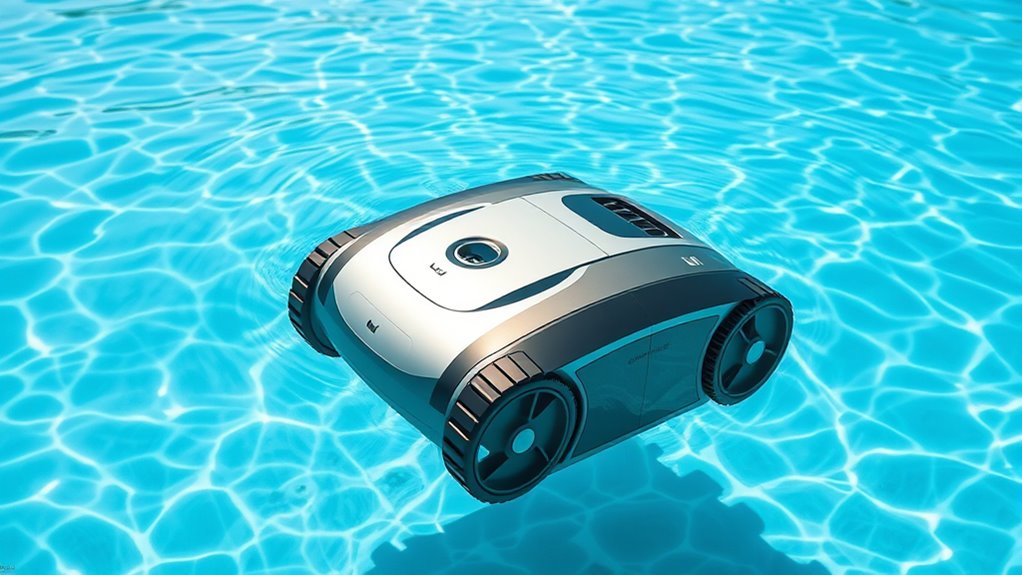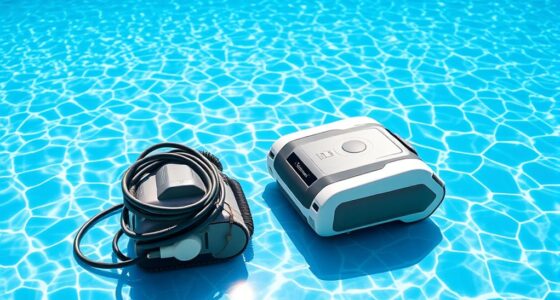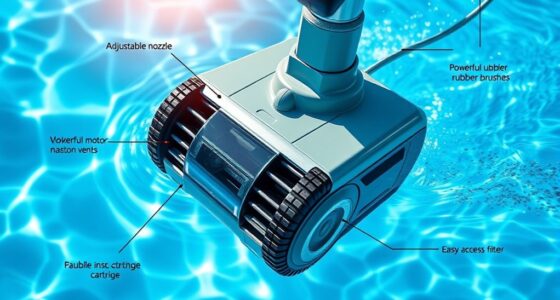The robotic pool cleaner market is rapidly expanding as consumers seek convenient, eco-friendly, and advanced cleaning solutions. Increased demand stems from preferences for smart technology, sustainability, and efficient performance, especially during warmer months. Market growth varies across regions due to climate, income, and regulations, while key players focus on innovation and eco-friendly designs. However, challenges like supply chain issues and high costs remain. If you explore further, you’ll discover how the industry is evolving to meet future needs.
Key Takeaways
- Market growth driven by consumer demand for convenience, eco-friendly features, and advanced cleaning technology.
- Technological innovations like smart navigation, sensors, and real-time mapping enhance cleaning efficiency and coverage.
- Leading brands invest in AI, sustainable materials, and product differentiation to maintain market dominance.
- Seasonal peaks, energy efficiency, and eco-conscious preferences fuel ongoing market expansion.
- Challenges include regulatory hurdles, supply chain disruptions, and high upfront costs, impacting growth potential.
Market Drivers and Consumer Preferences
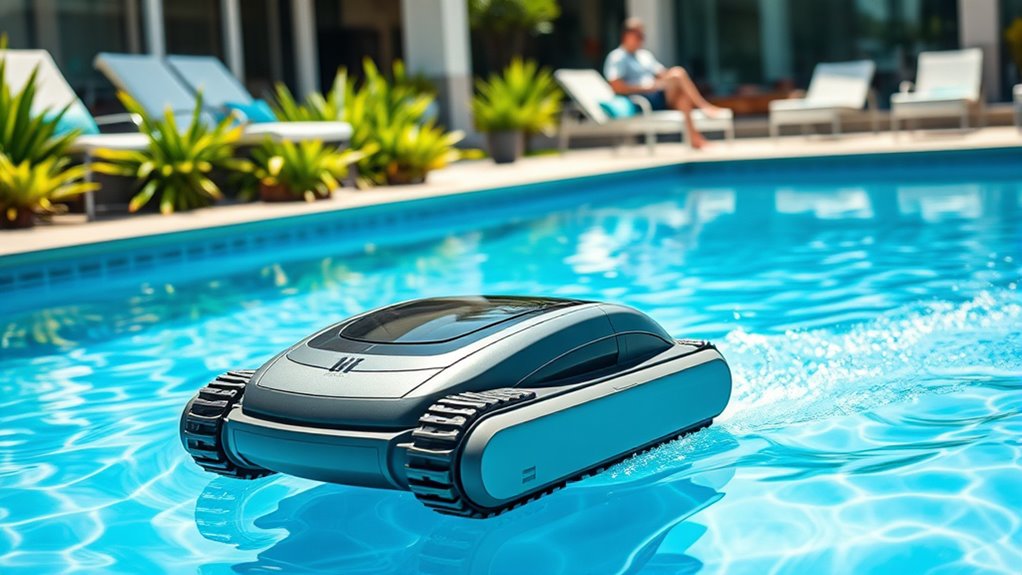
The growing demand for robotic pool cleaners is driven by consumers’ desire for convenience and time savings. Many buyers now prioritize eco-friendly materials in these devices, seeking products that are sustainable and reduce environmental impact. This preference aligns with a broader shift toward eco-conscious living. Eco-friendly materials are increasingly incorporated into product design, reflecting consumer values and environmental concerns. An emphasis on sustainable manufacturing practices is also gaining importance among consumers who want products that support environmental preservation. Additionally, the integration of advanced energy-efficient technologies helps reduce operational costs and minimizes energy consumption, appealing to eco-conscious buyers. Incorporating renewable energy sources into the design of these devices is another innovative step that enhances their eco-friendliness and efficiency. Seasonal demand also plays a significant role; during warmer months, homeowners want efficient solutions to keep pools clean without extra effort. As a result, manufacturers focus on offering eco-friendly models that appeal to environmentally aware consumers. The convenience of automated cleaning combined with eco-conscious features makes robotic pool cleaners more attractive, especially during peak swimming seasons. This blend of sustainability and seasonal needs fuels ongoing growth in the market. Additionally, innovations in automatic cleaning technology continue to improve efficiency and user satisfaction, further propelling market expansion.
Technological Innovations and Features

Modern robotic pool cleaners come equipped with advanced navigation systems that help them efficiently cover every inch of your pool. They also feature smart cleaning capabilities, allowing them to adapt to different pool shapes and conditions. These innovations make maintenance easier and guarantee a thorough clean with less effort on your part. Incorporating technological advancements such as improved sensors and control algorithms further enhances their effectiveness and efficiency. Additionally, the integration of tuning Hyundai models demonstrates how precise adjustments can optimize performance and reliability in various applications. As the automation industry continues to evolve, these features are expected to become even more sophisticated, providing users with smarter and more adaptable cleaning solutions. Incorporating sound recording techniques can also help improve the design and testing of these devices to ensure optimal functionality in diverse environments. Moreover, leveraging advanced data analysis can facilitate ongoing improvements and predictive maintenance for these robotic systems.
Advanced Navigation Systems
Advanced navigation systems have revolutionized robotic pool cleaners by enabling them to clean more efficiently and thoroughly. They use sophisticated sensors to improve sensor accuracy, ensuring precise detection of pool surfaces and obstacles. This minimizes missed spots and reduces unnecessary movements, saving battery life. These systems also optimize battery efficiency by planning the most effective cleaning routes, extending operation time. Incorporating crochet techniques can also enhance the design and customization of robotic pool cleaner accessories. Additionally, the integration of AI security features can help prevent malfunctions and unauthorized access to the device’s control systems. Moreover, implementing credit card security measures can protect user data during online updates and remote control functionalities. As technology advances, sensor accuracy continues to improve, further increasing the effectiveness of these cleaning systems.
Smart Cleaning Capabilities
Building on sophisticated navigation, smart cleaning capabilities leverage innovative technologies to enhance efficiency and effectiveness. These features enable your robotic pool cleaner to refine its cleaning path, maximizing coverage while minimizing time. Advanced cleaning algorithms analyze pool size, shape, and debris patterns, adjusting cleaning cycles for better robotic efficiency. Sensors detect dirt, algae, and obstacles, allowing the cleaner to focus on heavily soiled areas and avoid obstacles seamlessly. Many models incorporate real-time mapping, ensuring thorough coverage without repetition. The integration of smart features means your pool gets a more thorough clean with less effort from you. Additionally, Self Watering Plant Pots are an example of how smart technology can help maintain consistent conditions automatically. Furthermore, smart sensors can detect changes in water chemistry, ensuring optimal balance and sanitation. Automated cleaning schedules can be configured to fit your routine, ensuring consistent maintenance without manual intervention. Additionally, tuning options can optimize the performance of pool equipment, ensuring longevity and efficiency. By continuously adapting to your pool’s unique layout, these capabilities ensure your pool remains pristine, saving you time and energy while maintaining the highest level of cleanliness.
Regional Market Dynamics
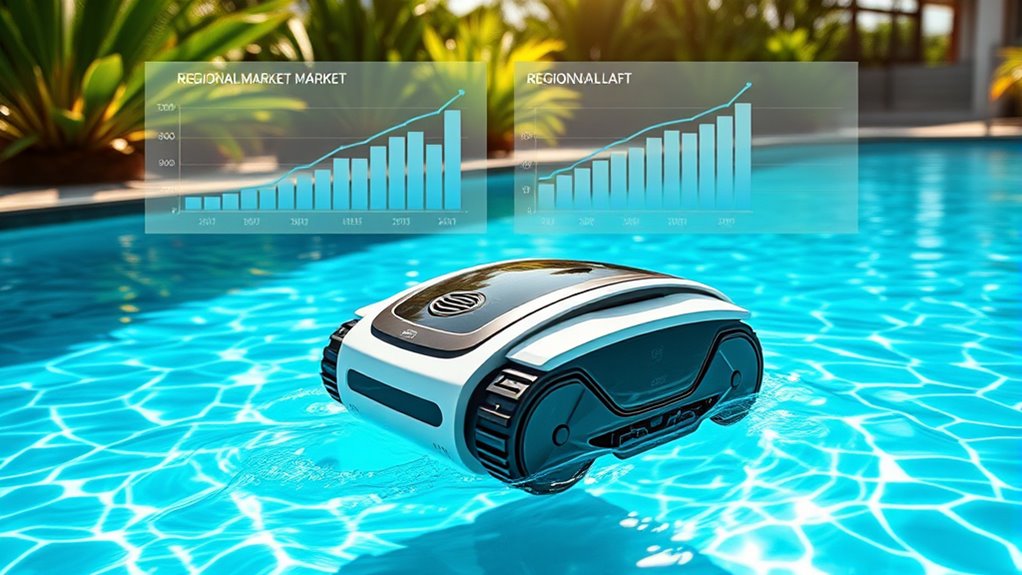
Regional market dynamics for robotic pool cleaners vary markedly across different parts of the world, driven by factors like climate, disposable income, and local infrastructure. You’ll find that regional regulations influence product standards and safety requirements, shaping market offerings. In regions with strict regulations, manufacturers focus on compliance to gain trust and market access. Cultural preferences also play a role; in areas where pool aesthetics and maintenance are highly valued, demand for advanced, feature-rich models increases. Conversely, in markets with lower disposable income, affordability becomes a key factor. Additionally, infrastructure such as access to reliable power sources impacts adoption rates. Understanding regional regulations and infrastructure differences helps you identify growth opportunities and tailor marketing strategies effectively across different geographic areas. The variability in technological adoption across regions further influences how quickly new features are embraced. Moreover, geopolitical tensions can affect supply chains and market stability in certain regions, creating additional considerations for market expansion. Recognizing regional market characteristics is essential for developing successful strategies in this evolving industry. For example, market-specific consumer preferences can significantly influence product customization and marketing approaches.
Competitive Landscape and Key Players
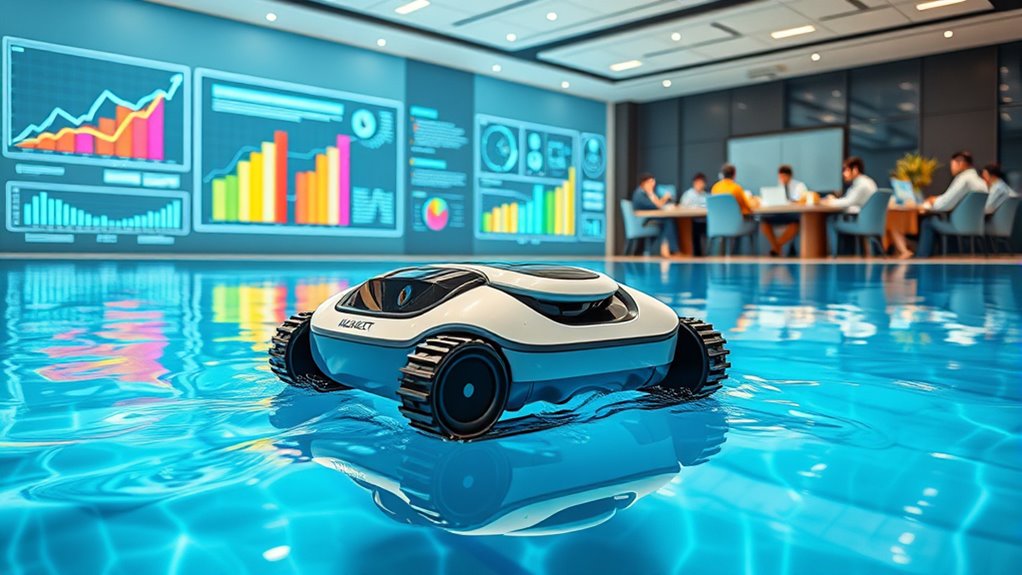
You’ll want to examine who the leading brands are and how their market shares compare. Understanding their innovation strategies can reveal how they stay ahead in a competitive landscape. This overview sets the stage for exploring how these key players influence the industry’s future growth. Additionally, embracing new trends can help companies differentiate themselves and capture emerging opportunities in the market. Staying informed about market dynamics can further enhance strategic decision-making and competitiveness.
Leading Brands Overview
The robotic pool cleaner market is dominated by a handful of key brands that continually innovate to stay ahead. These brands have built strong brand reputations by delivering reliable, high-quality products that meet consumer needs. You’ll find that their reputation for durability and performance influences your purchasing decisions. Pricing strategies vary among these companies, ranging from premium options with advanced features to more affordable models for budget-conscious buyers. They often adjust prices to stay competitive while maintaining quality standards. As a result, you can expect a range of choices that balance cost and performance. Leading brands focus on innovation, customer satisfaction, and strategic pricing to ensure they remain top contenders in the market.
Market Share Distribution
Who currently dominates the robotic pool cleaner market, and how is the competitive landscape shaped? Major brands like Dolphin, Hayward, and Polaris hold significant market share, driven by extensive distribution channels and brand recognition. Market segmentation reveals that consumer demographics heavily influence market distribution; homeowners with larger pools or higher incomes tend to prefer advanced, feature-rich models, while budget options appeal to cost-conscious buyers. Key players target specific segments, shaping the competitive landscape. Smaller, innovative companies are gaining ground by focusing on smart technology and eco-friendly designs, but dominant brands maintain leadership through brand loyalty and product reliability. Overall, the market is segmented by consumer needs and demographics, creating a competitive environment where understanding these segments is vital for market positioning and growth.
Innovation and Strategies
Major brands like Dolphin, Hayward, and Polaris lead the robotic pool cleaner market by investing heavily in innovation and strategic initiatives. They focus on AI integration to enhance cleaning efficiency, enabling devices to adapt to different pool layouts and debris types. These companies are also prioritizing the use of sustainable materials to reduce environmental impact, appealing to eco-conscious consumers. Strategic partnerships and R&D investments help them stay ahead of competitors, driving product differentiation. Advanced AI features improve navigation and obstacle detection, while sustainable materials ensure durability and eco-friendliness. By continuously refining their technology and eco-friendly approaches, these brands aim to strengthen their market positions and meet evolving consumer demands for smarter, greener pool cleaning solutions.
Challenges and Barriers to Growth
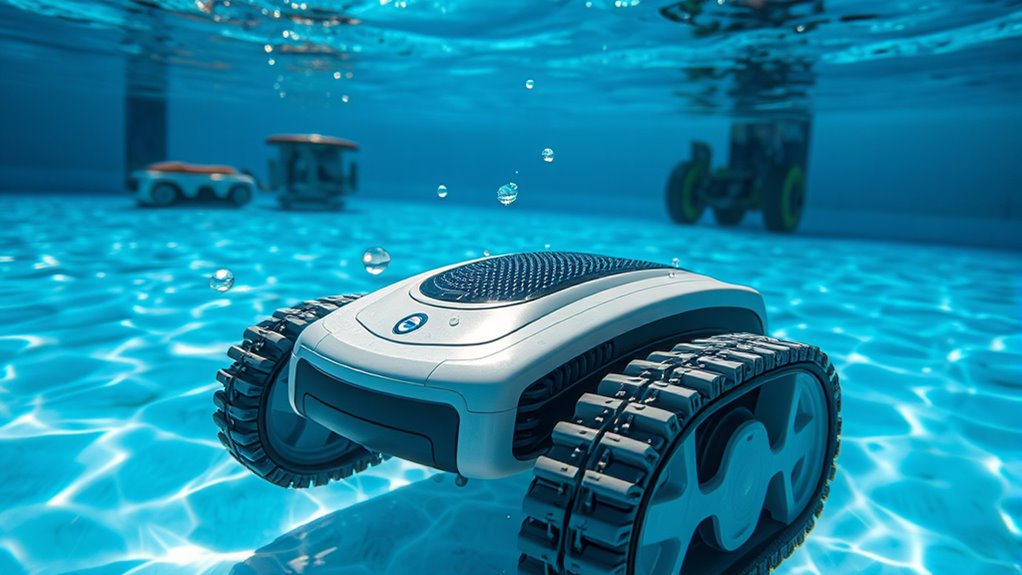
Despite the growing popularity of robotic pool cleaners, several challenges hinder their widespread adoption. Regulatory hurdles can slow innovation and create compliance costs that limit market entry. Supply chain disruptions also pose significant obstacles, delaying production and increasing prices. Additionally, high upfront costs make some consumers hesitant to invest. Limited awareness and trust in newer technologies further restrict growth.
- Regulatory hurdles complicate product approval and compliance.
- Supply chain issues cause delays and price hikes.
- High initial costs deter potential buyers.
- Consumer understanding of benefits remains limited.
These barriers require manufacturers to navigate complex regulations and optimize logistics. Overcoming these issues is essential to liberatethe full market potential and increase adoption among a broader consumer base.
Future Trends and Industry Outlook

What does the future hold for robotic pool cleaners? You can expect advancements focused on sustainability and customer satisfaction. Manufacturers are investing in eco-friendly materials to reduce environmental impact, making these devices more sustainable. Smart technology will continue to evolve, offering better navigation and cleaning efficiency. Enhanced customer service, including remote support and customizable features, will become standard. Here’s a glimpse of upcoming trends:
| Trend | Impact | Key Focus |
|---|---|---|
| Eco-friendly materials | Reduces environmental footprint | Sustainability |
| AI-powered navigation | Improves cleaning coverage | Efficiency |
| Enhanced customer support | Builds brand loyalty | Customer satisfaction |
| Smart integrations | Offers remote control, monitoring | Convenience |
These trends signal a cleaner, greener, and more connected future for you.
Frequently Asked Questions
How Do Robotic Pool Cleaners Impact Traditional Cleaning Methods?
You see, robotic pool cleaners impact traditional cleaning methods by integrating smart technology, which allows them to operate efficiently and autonomously. They’re designed with energy efficiency in mind, reducing power consumption compared to manual skimming or scrubbing. As a result, you spend less time and effort maintaining your pool, making traditional methods less necessary. This shift to smart, energy-efficient devices transforms how you keep your pool clean and saves you money.
What Are the Environmental Benefits of Robotic Pool Cleaners?
Did you know robotic pool cleaners use up to 80% less energy than traditional ones? They offer eco-friendly benefits by reducing chemical use and energy consumption, making your pool cleaner more sustainable. Plus, they promote water conservation by efficiently filtering debris, minimizing waste and unnecessary water changes. By choosing a robotic cleaner, you’re helping protect the environment while keeping your pool spotless and saving on utility bills.
How Does Maintenance and Repair Influence Overall Market Growth?
Maintenance and repair considerably influence market growth because they impact user satisfaction and long-term costs. If maintenance costs are high or repair services are scarce, customers might hesitate to invest in robotic pool cleaners. Providing affordable maintenance options and reliable repair services encourages more buyers, boosting sales and market expansion. When companies focus on ease of maintenance and accessible repairs, they foster customer trust, ultimately driving growth in the market.
What Are Customer Satisfaction Levels With Current Robotic Pool Cleaner Models?
You’re likely curious about customer satisfaction levels with current robotic pool cleaner models. Based on customer feedback, many users appreciate features like efficient cleaning, ease of use, and durability. However, some express preferences for improved navigation and longer battery life. Overall, satisfaction remains high, but manufacturers can boost it by addressing these feature preferences, ensuring their models meet customer needs and enhance their swimming experience.
How Do Seasonal Variations Affect Robotic Pool Cleaner Sales?
You’re likely to notice that seasonal demand for robotic pool cleaners fluctuates wildly, almost like the weather patterns themselves. As temperatures rise and fall, sales surge in summer and dip in winter. This pattern impacts inventory and marketing strategies, making it essential to adapt to seasonal variations. By understanding these trends, you can better anticipate customer needs and optimize sales efforts throughout the year, ensuring you’re always ahead of the curve.
Conclusion
As the robotic pool cleaner market blossoms, embracing innovation and inspiring industry insights, you’ll see swift strides and steady surges. Staying savvy with technological trends and regional shifts helps you capitalize on opportunities, avoid obstacles, and outpace competitors. With continued creativity and commitment, you’ll confidently carve a clear course toward a competitive, convenient, and cutting-edge future. Embrace evolution, energize enterprise, and enjoy the expansion ahead in this exciting, ever-evolving industry.
